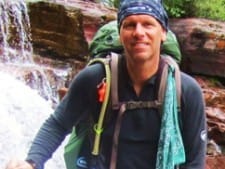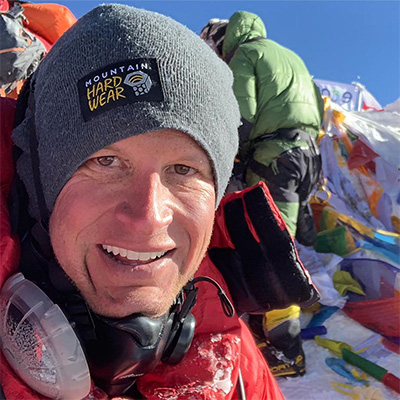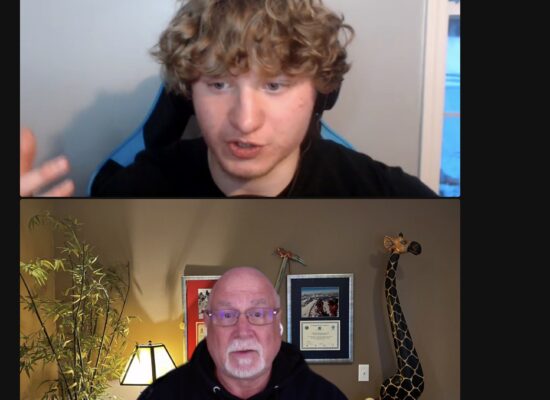 For 2014, I will be interviewing some of the smaller Everest guide services in addition to the climbers. The big name guide companies take about half of the total climbers to Everest so who guides the rest? There are many small companies to fill this gap including Dan Nash out of the US. I welcome suggestions for anyone climbing in 2014.
For 2014, I will be interviewing some of the smaller Everest guide services in addition to the climbers. The big name guide companies take about half of the total climbers to Everest so who guides the rest? There are many small companies to fill this gap including Dan Nash out of the US. I welcome suggestions for anyone climbing in 2014.
Now here’s Dan Nash:
Dan does not live in the Pacific Northwest, Colorado Rockies, Alaska or Nepal. No, he lives in springfield, Missouri where he has carved a great niche in the climbing and hiking world. Surrounded by the Ozarks that max out at 2,500 feet, he takes pride in helping people achieve their dreams.
Dan’s company Satori Adventures guides members around the world, including Everest. Like most small guides, he is not the lowest or highest price but comes in the middle of today’s price range. Over the past five years, he has put 13 people on the summit.
On Dan’s site, he explains the name Satori “… is a Buddhist term for enlightenment that literally means “understanding”. In the Zen Buddhist tradition, Satori refers to a flash of sudden awareness, or individual enlightenment and is considered a “first step” or embarkation toward nirvana. Satori Adventures and Expeditions assists in this individual enlightenment by providing our members with the possible outdoor experiences in some of the world’s most amazing locations. Our goal is to provide you with a life changing experience that will help transform and enrich your life for years to come.”
Dan is a field ambassador for Lowa boots and regularly tests and reviews gear for various outdoor companies and places like the Gear Institute, Backpackers Review and Backpacker Magazine. He is also the founder and editor of the site Hiking the Ozarks. And perhaps an emerging filmmaker!
Please meet Dan.
Q: Can you tell us a bit about your company Satori Adventures?
Satori Adventures & Expeditions is a small “boutique style” expedition guide service offering over 50 mountaineering and trekking expeditions in over 20 countries worldwide. We are affiliated with several local guide services that emphasize the same values we do – helping our members achieve a life-changing outdoor experience with guides who make safety their utmost concern. We are proud of our people and the experiences we offer. Satori was founded out of my love and passion for mountain climbing and trekking in the world’s most beautiful places; I want to help others experience that same love and passion.
Q: Do you have a favorite mountain in Peru or the Himalaya?
The Andes and the Himalaya both have so many amazing mountains, but I always seem to be drawn to those that offer a unique mountain experience that I can really share with others. For a beginner’s peak, I love Mt Pisco in the Andes, not only because it is a beautiful climb, but because I have had the opportunity to share this peak with so many wonderful people and climbers. To teach and share this experience with so many new climbers and to see the emotion – the joy and the pain – as they set out to achieve their goals of reaching the summit, makes me feel very lucky. These are the people that will carry this sport on into the future. In the Himalaya I love Cho Oyu for the amazing views and the massive bulk.
Q: You have been guiding for 15 years and seen a lot of changes. What are a couple of the most significant ones in your mind?
The popularity of mountain climbing continues to grow, so certainly the number of participants and number of guides has changed dramatically. Whereas mountains were at one time more for experienced climbers and trekkers, it has become a more inclusive sport, thereby making diversity in experience more noticeable. There are obviously more safety concerns with this, but the good thing is that it is nice to see more and more people getting out there to experience the beauty of the mountains and test their limits of what they can achieve.
Q: What are your thoughts on Everest these days, routes, safety, crowds, conflict?
I understand why Everest has become so popular. It is a beautiful mountain and the ability to summit it represents one of mankind’s great feats of physical and mental toughness. Unfortunately, the crowds can at times make it that much more dangerous for everyone. I am always saddened to hear about conflict in the area, especially because the Sherpa are such a wonderful and hard working people. Without the Sherpa, we could not accomplish the things we do on Everest. I worry that sometimes their quiet voice is not always heard nor defended. That makes me sad. And while climbing a mountain like Everest carries with it an inherent danger, it also saddens me that we do not better control the danger that we can control.
Part of what makes the Himalayan mountains so beautiful is that they are mountains that are lived in; it is a beautiful thing to pass by villages and get a taste of that culture on the mountain. But I worry that tourists and the Nepalese government does not always take this into consideration in protecting the area in which these people have lived for thousands of years.
Q: What is the profile of your typical member and team size?
For the bigger peaks, we typically have smaller teams, around 4-6 climbers. I like this size as this gives us the chance to really get to know our members much better, plus it really affords our guides the opportunity to teach the members and be educators and mentors on the mountain. Due to the variety of trips we offer, our members range from amateur members attempting their first peak, and experienced members attempting one of the various 8,000 meter peaks that we offer.
Q: Please tell us a bit about your film “Ordinary Mountaineers”?
There are so many films about professional mountaineers, so I really wanted to do something very different. I really find it so special to watch others, whether they are complete beginners or someone who has climbed a mountain in the past. What trials and tribulations they go through to get themselves up the mountain? What demons do they have to fight to do it? Whether they succeed or fail, what joys will they experience as they discover a new challenge and new people to share it with? I wanted to make a movie about how amateur climbers would answer these questions, each unique and special in his or her own right, and each with their own reasons for being there, and how the experiences of those people might encourage others to give it a try. “Ordinary Mountaineers” is a short film about 16 people who tackle Mt Pisco in Peru in the summer of 2013. We are very proud of this film and of the people who participated in its making.
Here is the trailer
Q: How is your 2014 Everest climb looking?
Our team is beginning to come together nicely, everyone seems very excited and all are making their last minute preparations for the trip. The team seems strong with climbers from both Europe and North America, including two very experienced climbers. We are excited for them to embark on this journey up this magnificent mountain.
Best of luck this year Dan. One of his climbers is Francesco Rovetta who met Dan on a trek to Everest Base Camp and then climbed Island peak 3 years ago, and then again to Pisco and Chopicalqui in Peru 2 years ago. You can follow his season on his site.
Climb On!
Alan
Memories are Everything




One thought on “Everest 2014: Interview with Dan Nash – Small for a Reason”
I really enjoyed your question and answer session with Dan. It is always interesting to hear the thoughts and opinions of others, especially the lesser known guides. Thank you for posting Cheers Kate
Comments are closed.